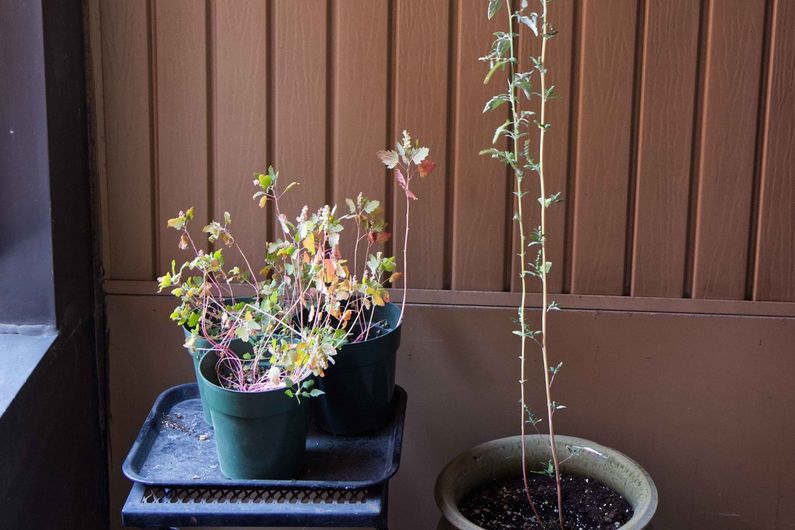The genome of a lost crop is explored
- UdeMNouvelles
03/15/2023
- Jeff Heinrich
Scientists led by a geneticist at Université de Montréal have sequenced the genome of pitseed goosefeet, a northern relative of South American quinoa, with the potential to boost food diversity.
Climate change is disrupting agriculture around the globe, and as the weather becomes less predictable, farmers and policy-makers are scrambling to make sure that people not only have enough to eat, but also that they get the most nutritious foods available.
A team of Canadian scientists is exploring a way, grounded in centuries-old Indigenous cultivation practices, to boost the diversity of crops beyond the country's typical output of wheat, corn, canola and oats.
Led by Université de Montréal geneticist Mark Samuels, the researchers have succeeded in sequencing the genome of a wild plant called Chenopodium berlandieri – or pitseed goosefeet – that is a northern relative of Chenopodium quinoa, South American quinoa.
These days, health-conscious Canadians are eating more and more quinoa. It has several advantages over other crops: higher in protein and essential amino acids (especially lysine, which wheat and corn have much less of), and lower in sugars.
But there's a problem, at least from a Canadian standpoint.
Commonly grown in South America, quinoa is not well-adapted for cultivation in Canada, where the growing season is shorter and winters long. Although it's commercially grown in western Canada, it has been less successful in eastern Canada. Most of what we eat here is imported.
Enter quinoa's northern relative, C. berlandieri. It's commonly called pitseed goosefoot because its leaves look like goose feet and its seeds have small pits on their surface. (The Chenopodia are a large family of species; quinoa and pitseed goosefoot are just two.) Pitseed goosefoot was long cultivated and eaten by Indigenous peoples in North America, before the arrival of European colonists. It was like quinoa in South America, but colonization brought an end to its cultivation, whereas quinoa survived as a crop in the south. The two species are still sufficiently similar that they can freely interbreed.
As a native Canadian plant, pitseed goosefoot can potentially be used to improve adaptation of quinoa in Canada. "The classic way to use wild plant relatives to better adapt crops is to cross them, creating hybrids," Samuels said. "But hybrids lack the advantages of the parents, so they have to be re-crossed and re-crossed for many generations, which takes years, decades or even centuries."
With new genomic tools, however – in this instance, using sequencing to determine the precise genome of C. berlandieri – "it's possible, in principle, to enormously reduce the time required to better adapt a crop such as quinoa to a new environment – it could be a game-changer," said Samuels, an associate professor of medicine at UdeM.
He describes his team's success with C. berlandieri in a study published last month in the scientific journal Plants. The team includes Drs. Sara Halwas and Anne Worley of the Departments of Anthropology and Biological Sciences at the University of Manitoba. Halwas has studied the agricultural practices of indigenous peoples, pre-European contact, including an interdisciplinary PhD on C. berlandieri with Worley. They provided the sample of Manitoban C. berlandieri that was sequenced.
Beyond facilitating the adaptation of quinoa to broader cultivation in Canada, the project also has the more amibitious goal to take C. berlandieri out of the wild and re-domesticate it for North American agriculture – without the very long development time that would normally be needed to make it farm-ready.
Now, thanks to genomics, what was once part of the historical Indigenous culture could be grown again to meet a pressing need: diversifying what Canadians have available to them to eat, without wastefully importing what is essentially an identical species of plant.
"Pitseed goosefoot has been more or less forgotten, but with genomics we could revive the cultivation of this native plant," observed Samuels, who is now talking to members of First Nations communities who have expressed an interest in his research.
First presented last June at the annual conference of the Canadian Botanical Association, in Rouyn-Noranda, the work was done in collaboration with expert researchers at the UdeM-affiliated Institute of Research in Plant Biology, at Montreal's Botanical Garden.
Crediting his UdeM colleague Etienne Léveillé-Bourret for guidance in a field new to him, Samuels has for most of his career focused on human medical genetics; he has a lab at the UdeM-affiliated CHU Sainte-Justine Research Centre.
With his new study, the polyvalent scientist is branching into plant genomics.
"It's a natural extension, since nutrition is an important aspect of health, and in the past I worked a lot on cholesterol genomics, which has a nutritional angle," noted Samuels, a dual-American-Canadian citizen who married into a Newfoundland farming family.
"I couldn't have predicted I'd get into quinoa in a big way but I look forward to doing more."
About this study
Genomic sequence of Canadian Chenopodium berlandieri: a North American wild relative of quinoa," by Mark Samuels et al, was published Jan. 19, 2023 in Plants.














